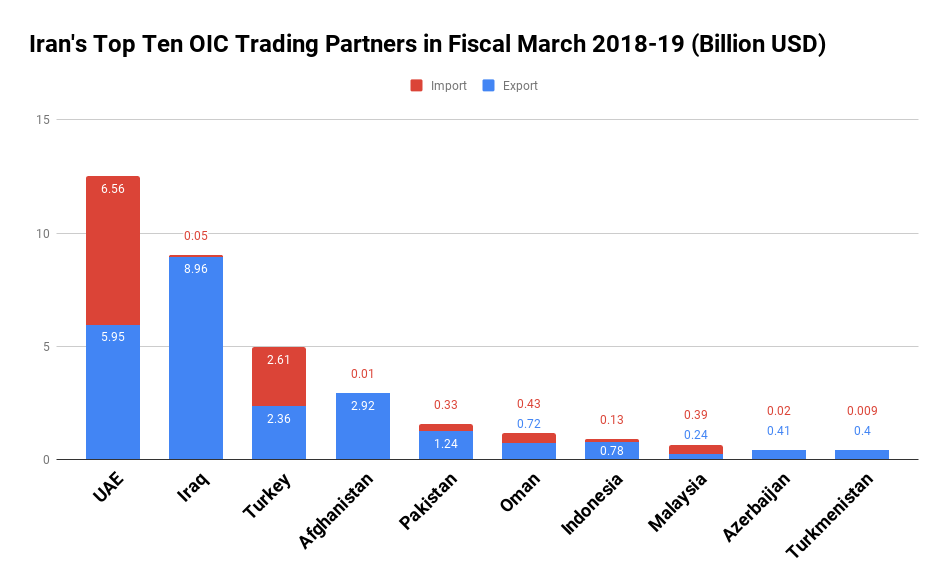Latest data released by the Islamic Republic of Iran Customs Administration show Iran’s exports totaled 64.18 million tons worth $25.55 billion during the year, indicating a 6.47% decline in tonnage and a 2.24% increase in value year-on-year.
Imports stood at 6.96 million tons worth $10.83 billion, down 35.42% and 28.41% in tonnage and value respectively YOY.
Iran recorded $14.72 billion in non-oil trade surplus with OIC member states, according to Financial Tribune.
Founded in 1969, the Organization of Islamic Cooperation is an international organization with 57 member states, including Iran, with 47 having a Muslim majority. Some, especially in West Africa, have large Muslim populations, but are not necessarily Muslim majority countries.
The organization states that it is the collective voice of the Muslim world and works to safeguard and protect the interests of the Muslim world in the spirit of promoting international peace and harmony. The collective population of OIC member states is over 1.9 billion as of 2018.
Syria has been suspended from the organization since August 2012. Therefore, it was not included in this report.
Main Commodities, Trading Partners
Iran mainly exported liquefied natural gas, gas condensates, low-density oils, mineral oils, gas, non-alloy semi-finished iron/steel products and bitumen to OIC member states.
In exchange, major commodities imported into Iran from OIC countries included semi- and wholly-milled rice, steam turbine parts, cellphones and butter.
In terms of total trade value, the UAE topped the list among OIC countries with Iran trade standing at 17.57 million tons worth $12.52 billion, down by 30.07% and 25.6% in tonnage and value respectively YOY.
Exports to UAE amounted to 13.75 million tons worth $5.95 billion to register a 24.53% and 12.06% decline in tonnage and value respectively YOY.
The UAE was Iran’s second biggest export destination among the countries under review and third in the world.
In return, the country exported 3.82 million tons of commodities worth $6.56 billion to Iran, down by 44.68% and 34.71% in tonnage and value respectively YOY.
The UAE was the top exporter of goods to Iran among the states and second in the world after China.

Gas condensates, low-density oils and mineral oils were the main commodities exported to UAE.
For its part, the UAE mainly exported steam turbine parts, cellphones, butter and turbojet parts to Iran.
Iraq was Iran’s second biggest trading partner among OIC nations during the period, as two-way commercial exchanges stood at 19.84 million tons worth $9.01 billion to register a 48.25% and 35.75% growth in tonnage and value respectively YOY.
Iran exported 19.76 million tons of goods worth $8.96 billion to Iraq, up by 49.15% and 36.71% in tonnage and value respectively YOY.
Iraq was Iran’s top export destination among neighboring countries and second in the world, after China, during the 12-month period.
Iran’s exports to Iraq included liquefied natural gas, mineral oils, detergents, low-density oils and tomatoes.
Iran imported 73,563 tons of commodities worth $58.69 million from Iraq, down 43.14% and 34.61% in tonnage and value respectively YOY, which mainly consisted of low-density oil, machinery, aluminum alloy and cans.
Iraq was the eighth exporter of goods to Iran among the neighbors and 41st exporter to Iran in the world.
Turkey was Iran’s third major trading partner among OIC states.
Mutual trade between Iran and Turkey amounted to 8.15 million tons worth $4.98 billion, indicating a 49.54% and 30.61% decline in tonnage and value respectively YOY.
Iran’s exports reached 6.76 million tons worth $2.36 billion, down 52.72% and 40.22% in tonnage and value respectively YOY, while Turkey’s exports to Iran hit 1.39 million tons worth $2.61 billion, down by 24.96% and 18.79% in tonnage and value respectively YOY.
Turkey was Iran’s fourth export destination as well as the second exporter of goods to Iran among the countries under review. The country was Iran’s sixth export destination and third exporter to Iran in the world, after China and the UAE.
Liquefied natural gas, non-alloy zinc, aluminum, urea and bitumen were Iran’s main goods exported to Turkey, while Turkey exported mainly cooking bananas, tobacco and fiber.
Afghanistan was Iran’s third biggest export destination, after Iraq and the UAE, among OIC states and fourth in the world, as Iran exported 5.67 million tons worth $2.92 billion to Afghanistan during the 12 months, down by 4.18% in tonnage and up by 5.11% in value YOY.
Iran mainly exported low-density oils, iron/steel bars and floorings to Afghanistan.
Oman was the third major exporter of goods to Iran among OIC members, after the UAE and Turkey, as Iran imported 385,286 tons of commodities worth $432.82 million from Oman, indicating a 50.01% and 99.75% growth in tonnage and value respectively YOY.
Iran mainly imported vehicles, pharmaceuticals, field corn, lentil, pod vegetables and barley from Oman.
Oman was the 16th exporter of goods to Iran in the world.
Highest Growths, Declines in Trade
Trade with Algeria ($29.19 million), Maldives ($157,609) and Burkina Faso ($441,639) saw the highest YOY growths of 310.64%, 239.93% and 163.59% respectively, while trade with Togo ($2.32 million), Guinea ($182,513) and Yemen ($1 million) witnessed the lowest declines of 96.26%, 90.55% and 88.07% respectively.
Iran’s exports to Algeria ($29.19 million), Maldives ($157,609) and Burkina Faso ($441,639 million) saw the highest growths of 310.65%, 239.93%, 163.59% respectively.
Imports from Oman ($432.82 million), Kyrgyzstan ($11.37 million) and Tajikistan ($26.1 million) saw the highest growths of 99.75%, 87.83% and 87.48% respectively while imports from Bahrain ($853,991), Saudi Arabia ($251,334) and Lebanon ($12.56 million) witnessed the highest declines of 84.56%, 82% and 67.25% respectively.


